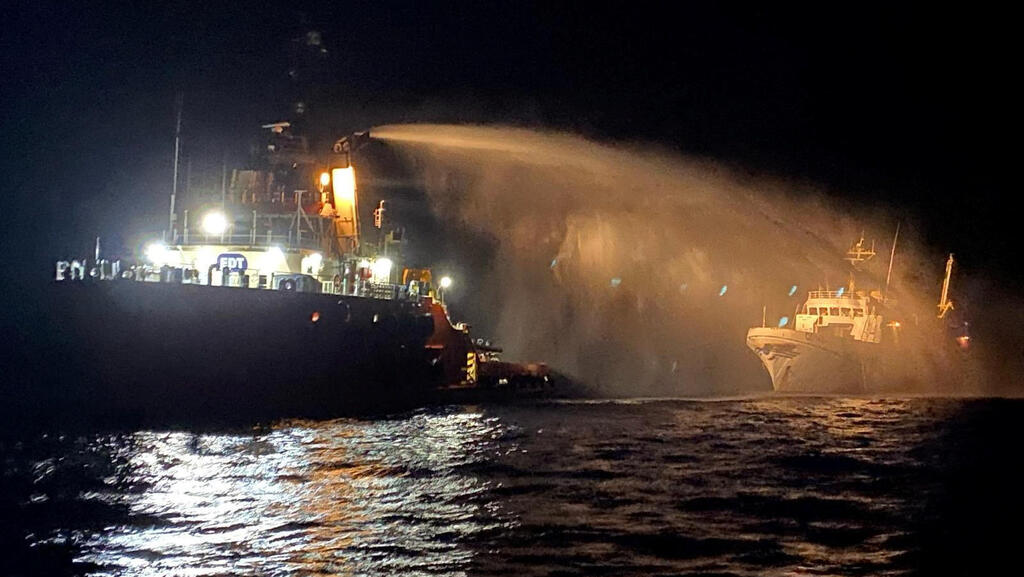It remains unclear when exactly the organizers of the “Freedom Flotilla,” aimed at delivering aid to Gaza in defiance of Israel’s naval blockade, intended to approach the enclave. What is known is that one of the vessels slated to participate in the flotilla was attacked near Malta, reportedly from the air.
According to the flotilla’s organizers, who are linked to Hamas, the ship, departing Tunisia several days ago, was targeted by drones. They told CNN and Maltese maritime authorities that they could not identify who carried out the attack but speculated that it was an Israeli drone or drones that fired munitions at the ship’s bow, where its generators are located. None of the passengers were injured in the strike, which occurred after midnight in the middle of the Mediterranean Sea.
Fire on the Gaza aid ship near Malta
Organizers claimed there were 30 people aboard the vessel. However, Maltese maritime authorities, who dispatched a tugboat and another support ship to assist, reported only 12 crew members and four civilians on board. They also denied the organizers' claim that the vessel was sinking, stating that the fire onboard had been brought under control. According to Saudi-owned Al Arabiya, citing a Western security source, the targeted ship was indeed part of a flotilla “planned to confront Israel.”
Given the history of the “Freedom Flotilla” to Gaza and the currently available details, a general picture can be drawn of the unusual incident in the Mediterranean—some 2,000 kilometers from Israel. The original “Freedom Flotilla” took place in May 2010 and led to a violent confrontation at sea between the Israeli Navy and ships sailing from Turkey, organized by the Turkish NGO IHH. That group has ties to Hamas-affiliated charities and to the Muslim Brotherhood.
In the clash off the Israeli and Gaza coasts, 10 passengers aboard the Turkish ship Mavi Marmara were killed in a fight with Israeli Shayetet 13 naval commandos, who boarded that ship and others in the flotilla. Since then, additional attempts have been made—by IHH and other organizations—to organize protest flotillas under the pretext of delivering humanitarian aid to Gaza.
Since October 7, there have been three such attempts. In one case, early in 2024, IHH transferred aid to the Jordanian port of Aqaba, and from there, with Israel’s approval and supervision, it was sent into Gaza. In recent years, various pro-Palestinian activists have publicized plans for further flotillas, some from Europe and others from Turkey. Apart from one flotilla intercepted by the Israeli Navy in 2018, none have approached Gaza’s shores—especially not in the past year. Israel has managed to track their points of origin and organizers and has foiled them through quiet diplomatic engagement with the countries involved.
Israeli officials have declined to comment on the incident at sea. However, if the widespread media assumption that Israel was behind the strike proves true, it suggests several things.
Get the Ynetnews app on your smartphone: Google Play: https://bit.ly/4eJ37pE | Apple App Store: https://bit.ly/3ZL7iNv
First, it would show that Israel has internalized the lessons of the violent Mavi Marmara confrontation, which caused a major diplomatic rift with Turkey and severely damaged Israel’s international image as a law-abiding state. Rather than allow the flotilla to organize—likely in Turkey—the party that struck the ship appears to have opted to send an early warning to the organizers: a so-called “knock on the bow,” meaning: “We will stop you by any means necessary before you even approach Gaza.” The goal was likely to signal intent without sinking the ship or harming passengers, in the hope that the message would be understood.
Such a signal may also have been meant to spare the Israeli Navy from having to face down multiple ships and passengers as in the Mavi Marmara case. According to those on board the targeted vessel, the strike was carried out by armed drones, indicating the high-level aerial capabilities of the attacker. To strike a specific location on a ship from over 2,000 kilometers away requires the capabilities of a regional power. While Iran and the Houthis do operate drones at these distances, the precision of Houthi drones is generally considered to be quite limited.
Using drones also provides the attacker with "plausible deniability." Had fighter jets been used, aerial refueling would have been required, and civil aviation authorities across the Mediterranean would likely have detected the aircraft and refueling operations, making it clear where the mission originated and where it returned. In contrast, small drones are hard to detect using the conventional radar systems employed by civilian and national aviation authorities in Europe. They leave little in the way of a detectable electronic signature, and even when such a signature is picked up, it’s difficult to attribute it definitively.
The combination of an early, calculated warning strike; the use of drones to preserve operational anonymity; and the intelligence that enabled the operation all point to sophistication, experience, and capability on the part of whoever targeted the pro-Palestinian vessel near Malta. Those same capabilities could be applied to other targets as well.





